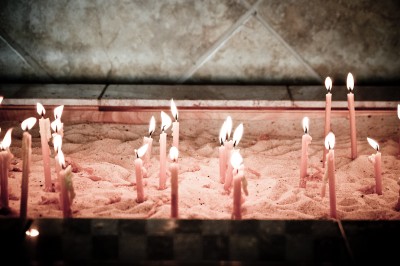
In the early 90’s, ethnic conflict tore Yugoslovia apart along religious lines, driving thousands refugees in search of peace elsewhere. One of the largest groups to arrive in the the Seattle area were Orthodox Christians, most of them Serbian.
When they got here, many of them found a home at St. Sava’s Serbian Orthodox church in Issaquah. It became a place where Serbians could feel a little closer to the place they left behind, and find people who shared the same pain, memories and nostalgia.
Two decades later, most of these refugees feel right at home here in the northwest, but many are still coming to St. Sava’s.
I visited the church last weekend for the celebration of “Pascha” or Orthodox Easter.
For a complicated array of reasons, Orthodox Easter is sometimes (but not always) celebrated on a different Sunday than the Western Holiday.
But regardless of the date, the celebrations are quite different then the egg-bearing rabbits to which many of us are accustomed.
More than 70 people turned out for the two day celebrations. They brought home-prepared meals to share, from delicately painted eggs to traditional Serbian dishes.
The celebration began last Saturday with a Midnight mass. As the church’s choir sung, each one of the devotees held a candle and whispered a prayer. Sunday morning Father Ilija Balach, who has been priest at the church for the past ten years, performed the Divine Liturgy – the primary worship service of the church.
After the service, people gathered together to enjoy communion breakfast. They gathered again in the church at about 11:30 a.m. for yet another service. The celebrations were closed out by a picnic lunch – my favorite part!

There may not be any Peeps or chocolate bunnies to be found in Orthodox Easter, but there are a lot of eggs. It turns out that the mainstream American tradition of decorating eggs is actually rooted in the Orthodox practice. But these eggs are always dyed red, representing the blood of Christ. The egg itself is a symbol of the empty tomb of Jesus, and of the resurrection that the Easter holiday commemorates.
During the picnic celebration, I sat down with Gerogiana Gavrilovich, one of the original founders of St. Sava’s Church. She said that more than half of the church’s current members are refugees. The demographics of the church changed after the immigration wave, because many of the devotee refugees were children and are now young adults. It provided a youthful energy to what had been an aging congregation.
But regardless of status or age, for Gavrilovich, it’s all about the religion and the togetherness of the community: “I’m just thankful that so many people come to resurrect their own lives.”

